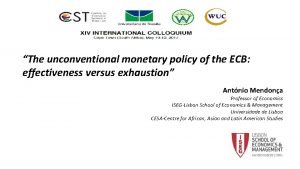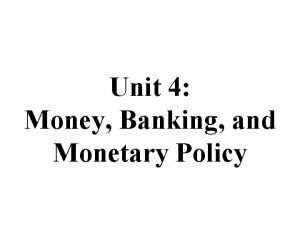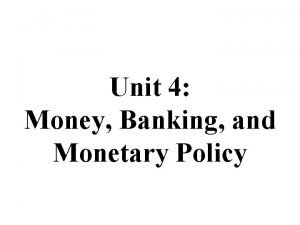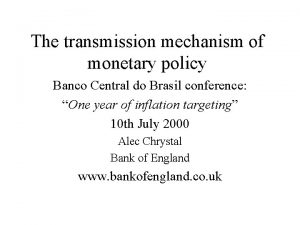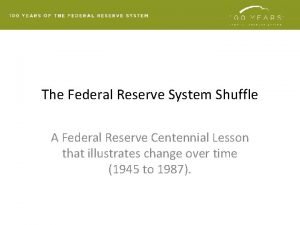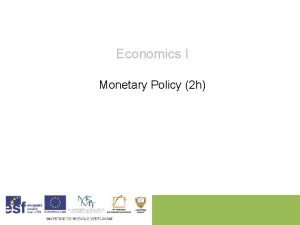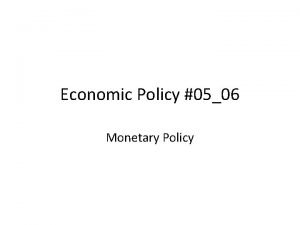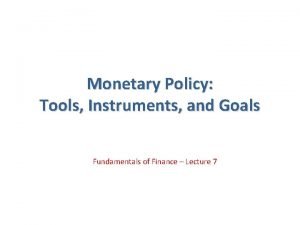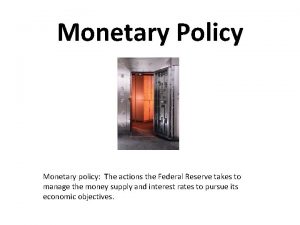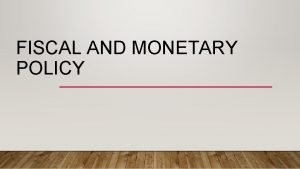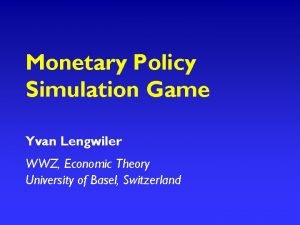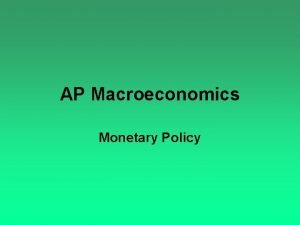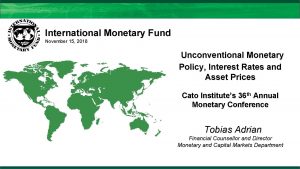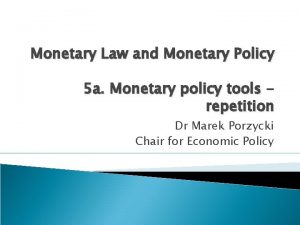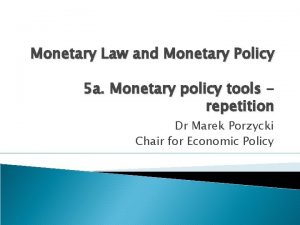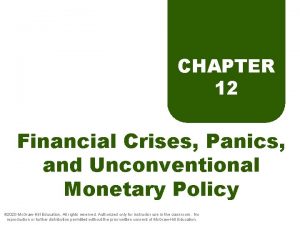Unconventional Monetary policy In response to 20078 financial
















- Slides: 16

Unconventional Monetary policy

• In response to 2007/8 financial crisis, central banks around the world began reducing short-term policy interest rates. • For example, on 8 October 2008, as the financial crisis intensified, central banks in Canada, China, the euro area, Sweden, Switzerland, the UK, and the US all undertook a coordinated rate cut. • But, faced with the prospect of a deep economic downturn, and with short-term interest rates close to the zero lower bound, central banks judged that further monetary stimulus would be required to meet their objectives. • They embarked on a range of measures that can broadly be described as unconventional monetary policy.

CONVENTI 0 NAL UNCONVETIONAL MONETARY POLICY: Quantitative Easing (QE) • QE typically involves large-scale asset purchases financed by the issuance of central bank money. These sorts of programmes of asset purchases have been put into practice by the Federal Reserve, the Bank of England, and the Bank of Japan, and are sometimes labelled conventional unconventional monetary policy. The key distinguishing feature of QE is that it involves the central bank seeking to directly affect asset prices—for example, longer-term gilt yields—other than a short-term interest rate and doing so by actively varying the size of its balance sheet.

QE • The Bank of England has overwhelmingly bought UK government bonds from the non-bank private sector through its QE operations; • the Fed has bought US Treasuries but also large quantities of agency debt and agency-backed mortgage backed securities. The differences between the assets bought by the Fed and the Bank of England are in fact not so great, because the bulk of the mortgage-backed securities are guaranteed by the US agencies, which are in effect government agencies. • The expansion of the European Central Bank (ECB) balance sheet has come about largely though repo operations – that is, the provision of loans (many long term) in exchange for collateral (much of which are bank loans and not government bonds).

QE: Differences among central banks goals • The ECB long-term repo operations were designed to alleviate the acute funding difficulties that many banks of Eurozone periphery had ( a sort of bank run problem. ) • The Bank of England the Fed asset purchase operations were not designed to handle a liquidity problem within the banking system. Rather, they were designed to affect the yields (or prices) on a wide range of assets – particularly on bonds issued to finance lending to companies and households.

HOW QE WORKS? • QE involves the monetary authority purchasing assets and injecting broad money into the economy. In doing so, QE tries to directly affect long-term interest rates. At the zero lower bound, the central bank has no room to further reduce short-term interest rates. How the QE works?


• The key difference between QE and a standard open market operation is that QE involves a direct injection of a specified quantity of broad money, rather than influencing its price through variations in the price of base money. • Another important difference is that central banks have gone beyond purchasing short-dated government securities, the policy pursued by the Bank of Japan between 2001 and 2006. Both the Bank of England the Federal Reserve have targeted longer-dated gilts, as well as private-sector assets, including corporate bonds and mortgagebacked securities (MBS). That is because the effectiveness of QE may depend on what is purchased, as well as how much.

Transmission Channel of QE

Transmission channel of QE : portfolio rebalancing • As the net supply of gilts of a certain maturity is restricted by the central bank intervention, their price increases (and yield falls)—a so called local supply effect. • In order to rebalance their portfolios, investors will seek to re-invest the money they hold, searching for alternatives to government bonds which are now more expensive. A natural response is for investors to acquire slightly more risky assets that are now relatively cheaper in comparison to domestic government bonds, for instance high-quality corporate bonds, foreign government bonds, or blue-chip equities. The sellers of those assets will then in turn seek to rebalance their portfolios by holding larger shares of riskier still assets. This process continues until all asset prices have adjusted such that investors, in aggregate, are willing to hold the overall supply of assets.

How QE works: portfolio rebalancing • The nature of the mechanism was initially described inter alia by Tobin (1961, 1963, 1969) and Brunner and Meltzer (1973). They stressed how central banks, through varying the relative supplies of financial claims with different durations (or maturities) and liquidity, could influence the pattern of yields on different assets due to imperfect asset substitutability. • An important ingredient of this portfolio balance channel is heterogeneity across agents – some people have to come to hold different portfolios and prices need to change to make this an equilibrium. Somebody ends up with more of one sort of a claim as a liability (the central bank has issued more money) and more of another as an asset, and someone else has taken the other side of that.

From asset prices to spending • Higher asset prices should stimulate increases in spending through both reducing the cost of capital and increasing wealth. • This argument relies on the portfolio rebalancing argument. This argument has been criticised by the «irrelevance proposition» Woodford (2012) • Krugman (1998). When interests are at the zero lower bound the only way to reduce real interest rate is to create expectations of higher inflation in the future. How to convince investors that monetary policy will in the future be looser than would normally be ? • This promise in dynamically inconsistent. However Both QE and forward guidance can be ssen as an attempt to signal the market that short term interest rates will be kept at a low level in the future.

«irrelevance proposition» • Woodford (2012) offers a concrete example to illustrate how the irrelevance proposition might work in practice. • If the central bank buys MBS, as the Federal Reserve has done, it takes real -estate risk on to its own balance sheet. While households will no longer directly be exposed in the event of a house price crash, the central bank will. • Therefore, in the crash state, the central bank’s earnings will be lower. And this will result in lower earnings distributed to the Treasury, which will in turn result in higher taxes levied on the private sector. • Thus, in aggregate, households’ post-tax income is equally affected in the event of a house price crash, whether or not they or the central bank hold MBS.

UNCONVENTIONAL MONETARY POLICY • forward guidance concerning short-term interest rates: providing information about the future path of policy • credit easing schemes: extended provision of short term and longer term liquidity to banks in order to ease credit conditions • long-term repo operations

Empirical evidence and future concerns • The consensus of the literature and the articles in this volume is that unconventional monetary policy does work – asset market purchases do lower yields and longer term interest rates and these lower yields in turn have a positive effect on the economy. This is why central banks are still contemplating further stages of QE. However, there also many things we do not know and several areas of concern. • The first is that even if QE has been effective in terms of boosting the economy, recovery still remains fragile.

Future concerns. • Another concern is that a high level of bank reserves might reduce the level of interbank lending and lead that market to malfunction. • Furthermore: When recovery occurs how will central banks reduce the level of reserves and avoid high levels of inflation? • Finally Fiscal implication: central bank purchases of government bonds are helping to contribute to unsustainable levels of government debt?
 Ecb unconventional monetary policy
Ecb unconventional monetary policy Unit 4 money banking and monetary policy
Unit 4 money banking and monetary policy Unit 4 money banking and monetary policy
Unit 4 money banking and monetary policy Transmission mechanism
Transmission mechanism Lesson quiz 16-1 monetary policy
Lesson quiz 16-1 monetary policy Objectives of monetary policy
Objectives of monetary policy Meaning of monetary
Meaning of monetary Types of monetary policy
Types of monetary policy Unit 5 macroeconomics lesson 2 activity 45 answer key
Unit 5 macroeconomics lesson 2 activity 45 answer key What are the objectives of monetary policy
What are the objectives of monetary policy What are the objectives of monetary policy
What are the objectives of monetary policy Contractionary monetary policy graph
Contractionary monetary policy graph Three tools of monetary policy
Three tools of monetary policy Monetary policy summary
Monetary policy summary Fiscal vs monetary policy
Fiscal vs monetary policy Monetary policy simulation game
Monetary policy simulation game Monetary policy types
Monetary policy types
